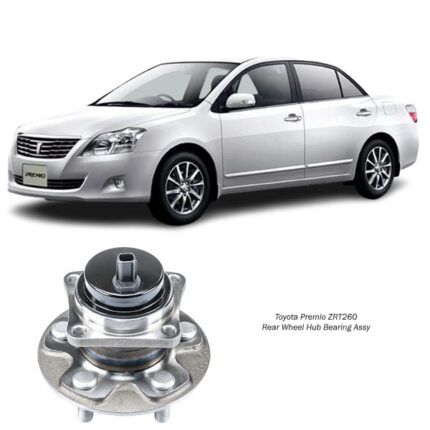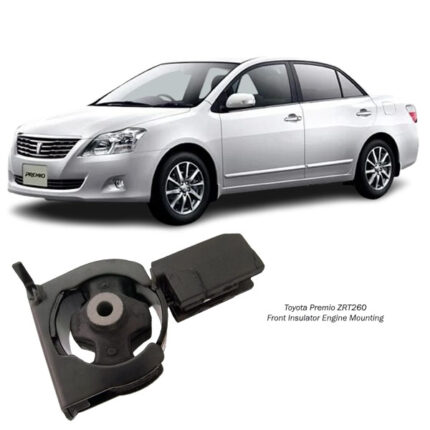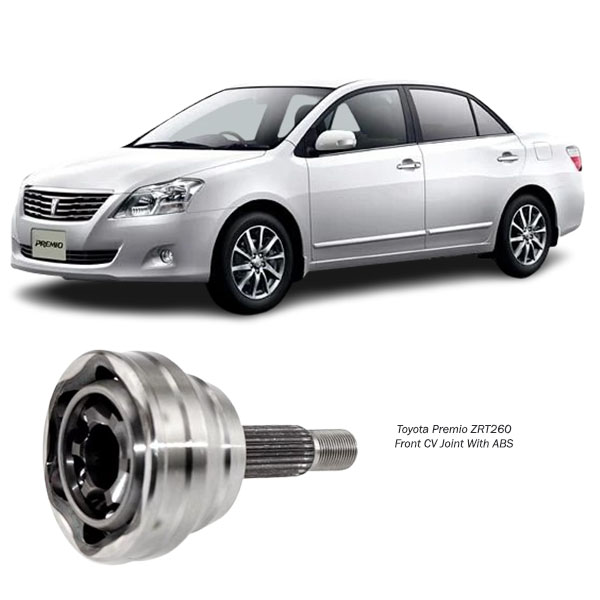-5%
Get Toyota Premio ZRT260 Front CV Joint With ABS TO-94A in Kenya
In the intricate world of automotive mechanics, few components are as hardworking and essential as the front CV joint with ABS. It’s a part that works quietly behind the scenes, helping power your ride while keeping it smooth, steady, and smart. Let’s dive deep into what this crucial part does, how it works, and why it matters so much for your vehicle’s performance and safety. 🚗⚙️
🔄 What is a CV Joint?
CV stands for Constant Velocity. The CV joint is a component that allows the front wheels of a vehicle to receive power from the engine while still being able to move up and down with the suspension and pivot for steering. Without it, turning or going over bumps would feel jerky, rough, or even impossible. 😬
In front-wheel drive and all-wheel drive vehicles, CV joints are typically found on both ends of the drive shaft (also called an axle shaft). The two common types of CV joints are:
-
Outer CV joints – Located near the wheel and allow steering movement.
-
Inner CV joints – Connected to the transmission or differential, accommodating up-and-down suspension travel.
🧲 What Does ABS Have to Do with It?
Modern front CV joints are often integrated with ABS (Anti-lock Braking System) technology. ABS helps prevent wheel lock-up during hard braking, ensuring better control and shorter stopping distances. 🛑🧠
On a CV joint with ABS, you’ll often find:
-
An ABS tone ring or reluctor ring—this is a toothed ring that spins with the axle.
-
A wheel speed sensor—this sensor “reads” the speed of the ring and sends real-time data to the ABS computer.
When you brake, the ABS system compares speed data from all wheels. If one is slowing down too quickly (risking a lock-up), it momentarily reduces brake pressure to that wheel—keeping you safely in control. 💡
🛠️ How Does a CV Joint Work?
The CV joint allows the wheels to rotate at a constant velocity while the suspension and steering are moving. Imagine driving around a bend while also hitting a bump in the road. The CV joint has to:
-
Transmit power from the engine,
-
Handle vertical movement from the suspension,
-
And accommodate the pivot needed for turning—all at once. 🤹♂️
The outer CV joint often resembles a ball-in-cage design—several steel balls ride in grooves between the inner and outer housings, letting the shaft bend while still spinning.
A rubber boot, known as a CV boot, protects this assembly. It holds in grease and keeps out dirt, water, and debris. If this boot cracks or splits, the joint can quickly wear out. 🔧🛢️
🔍 Symptoms of a Worn Front CV Joint with ABS
CV joints can last for many kilometers, but they are not invincible. Here’s how you can spot a failing one—especially one equipped with ABS components:
1. Clicking or Popping Noises When Turning 🔊
One of the most common signs of a bad CV joint is a click-click-click sound when turning sharply, especially at low speeds.
2. Grease on the Inside of the Wheel or Undercarriage 💦
If the CV boot is torn, it will leak grease. You might see splatters on the inside of the wheel or lower suspension components.
3. Vibration During Acceleration ⚡
A worn joint might cause the vehicle to vibrate as you accelerate, especially if the damage is severe.
4. ABS Warning Light 🚨
If the ABS ring or sensor on the CV joint is damaged or out of alignment, the system might trigger a dashboard warning light.
5. Unstable Braking 🛑
Without proper ABS function, you might notice strange behavior while braking, like premature wheel lockup or longer stopping distances.
🧰 What’s Involved in Replacing a Front CV Joint with ABS?
Replacing a front CV joint—especially one integrated with ABS—requires precision and mechanical know-how. Here’s a general overview of the process:
🔧 1. Vehicle is Lifted and Wheel Removed
Accessing the CV joint begins with lifting the vehicle safely and removing the front wheel.
🛑 2. Brake Assembly and Hub Disconnected
The brake caliper and rotor are removed, and the hub may need to be detached to free the axle.
🔓 3. CV Axle Removed from the Transmission or Differential
The inner joint is disconnected, and the axle shaft is carefully extracted.
🔄 4. New CV Joint (or Axle Assembly) Installed
In many cases, the whole axle shaft is replaced as one unit—especially if ABS components are built into the shaft.
✅ 5. ABS Sensor Checked and Recalibrated
The ABS sensor and ring are inspected, aligned, and recalibrated if needed. This ensures the warning light won’t come on unnecessarily.
🧪 6. Test Drive
A thorough road test checks for smooth operation, noise reduction, and ABS functionality.
🔒 Importance of Quality and Proper Fitment
Because this part is so critical to power delivery, steering, and braking safety, choosing a high-quality CV joint is essential. A poorly manufactured joint can lead to:
-
Premature wear 🕑
-
Poor wheel alignment 📐
-
ABS malfunction 🧯
-
Safety risks while braking or turning ⚠️
Whether it’s OEM or reputable aftermarket, ensuring that the ABS tone ring and sensor align properly is just as crucial as the joint itself.
🌟 Benefits of a Properly Functioning Front CV Joint with ABS
When in good shape, your front CV joint with ABS provides:
-
✅ Smoother handling
-
✅ Improved acceleration
-
✅ Reliable braking under emergency stops
-
✅ Quiet operation
-
✅ Peace of mind on every drive 🧘♂️
It’s the kind of component you don’t really notice when it’s working—but you definitely will when it’s not. 🧏♂️
🧼 Maintenance Tips to Prolong CV Joint Life
Want to keep your CV joint and ABS system in top shape? Follow these tips:
-
Inspect the CV boots regularly – Look for cracks, splits, or grease leaks. 🧐
-
Avoid harsh off-road driving – Excessive suspension flexing increases wear. 🏞️
-
Clean around the wheel hub – Keeps ABS sensors free from dirt and grime. 🧽
-
Listen for odd sounds – Clicking, clunking, or grinding needs immediate attention. 🔊
-
Act quickly on ABS warning lights – Don’t ignore your dashboard. 🚦
🛞 The Hidden Hero Under Your Ride
The front CV joint with ABS is a marvel of engineering. It juggles power, flexibility, and precision—all while protecting you with safety features like anti-lock braking. It’s an unsung hero beneath your vehicle, working hard with every turn, bump, and brake.
Keeping it in great shape is an investment in both performance and safety. And when it’s time to replace it, trust in skilled hands and quality components to keep your wheels rolling and your journey safe.
Follow us on Facebook for more parts.




Reviews
Clear filtersThere are no reviews yet.